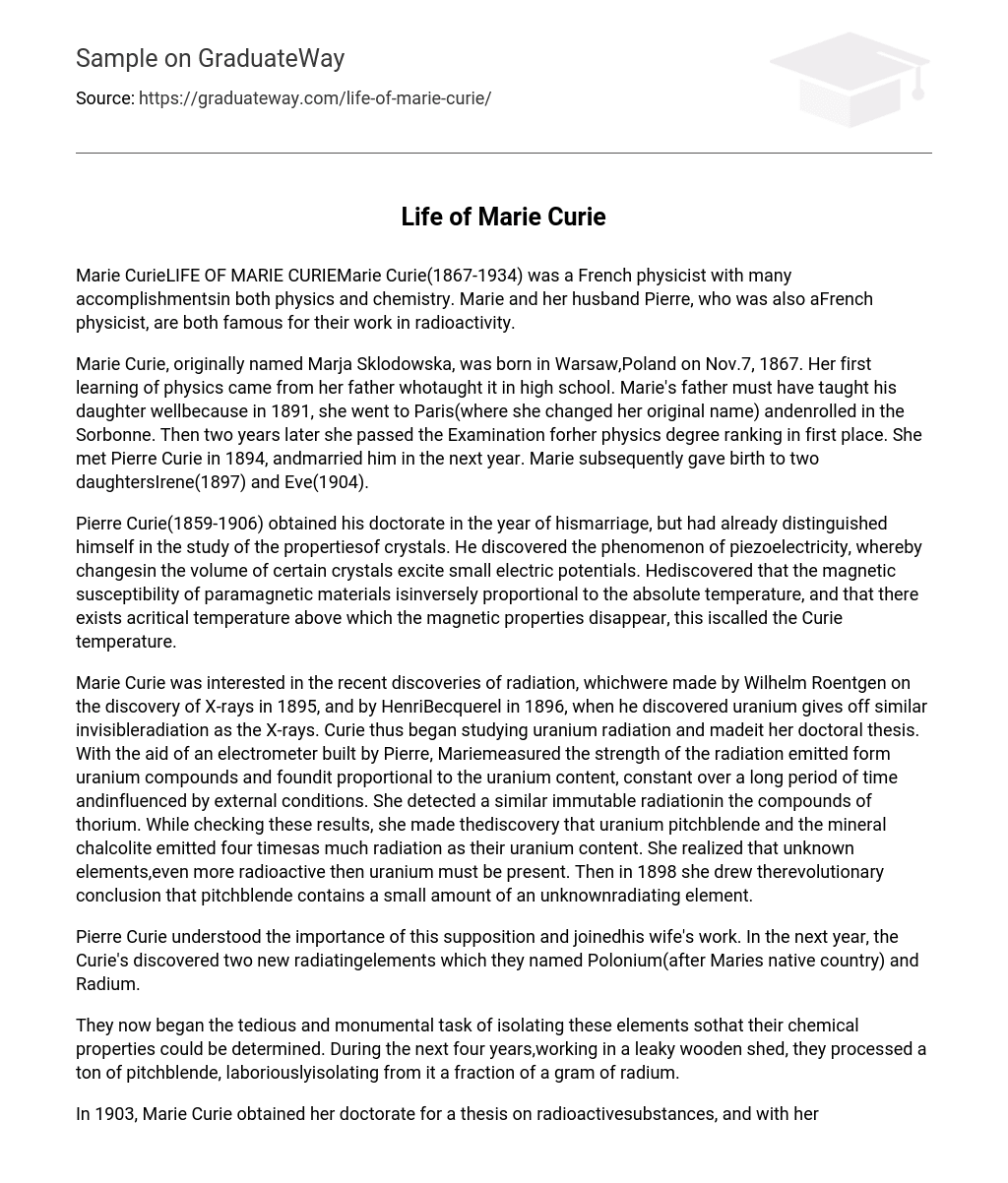Marie Curie(1867-1934) was a French physicist with many accomplishmentsin both physics and chemistry. Marie and her husband Pierre, who was also aFrench physicist, are both famous for their work in radioactivity.
Marie Curie, originally named Marja Sklodowska, was born in Warsaw,Poland on Nov.7, 1867. Her first learning of physics came from her father whotaught it in high school. Marie’s father must have taught his daughter wellbecause in 1891, she went to Paris(where she changed her original name) andenrolled in the Sorbonne. Then two years later she passed the Examination forher physics degree ranking in first place. She met Pierre Curie in 1894, andmarried him in the next year. Marie subsequently gave birth to two daughtersIrene(1897) and Eve(1904).
Pierre Curie(1859-1906) obtained his doctorate in the year of hismarriage, but had already distinguished himself in the study of the propertiesof crystals. He discovered the phenomenon of piezoelectricity, whereby changesin the volume of certain crystals excite small electric potentials. Hediscovered that the magnetic susceptibility of paramagnetic materials isinversely proportional to the absolute temperature, and that there exists acritical temperature above which the magnetic properties disappear, this iscalled the Curie temperature.
Marie Curie was interested in the recent discoveries of radiation, whichwere made by Wilhelm Roentgen on the discovery of X-rays in 1895, and by HenriBecquerel in 1896, when he discovered uranium gives off similar invisibleradiation as the X-rays. Curie thus began studying uranium radiation and madeit her doctoral thesis. With the aid of an electrometer built by Pierre, Mariemeasured the strength of the radiation emitted form uranium compounds and foundit proportional to the uranium content, constant over a long period of time andinfluenced by external conditions. She detected a similar immutable radiationin the compounds of thorium. While checking these results, she made thediscovery that uranium pitchblende and the mineral chalcolite emitted four timesas much radiation as their uranium content. She realized that unknown elements,even more radioactive then uranium must be present. Then in 1898 she drew therevolutionary conclusion that pitchblende contains a small amount of an unknownradiating element.
Pierre Curie understood the importance of this supposition and joinedhis wife’s work. In the next year, the Curie’s discovered two new radiatingelements which they named Polonium(after Maries native country) and Radium.
They now began the tedious and monumental task of isolating these elements sothat their chemical properties could be determined. During the next four years,working in a leaky wooden shed, they processed a ton of pitchblende, laboriouslyisolating from it a fraction of a gram of radium.
In 1903, Marie Curie obtained her doctorate for a thesis on radioactivesubstances, and with her husband and Henri Becquerel she won the Nobel Prize forphysics for the joint discovery of radioactivity. Finally, the Curies financialaspect was relieved, and the following year Pierre was made the professor at theSorbonne, and Marie the assistant. Everything was going well for the Curies,but then Pierre was run over by a horse drawn cart and killed. Marie was deeplyaffected by his death and overcame this blow only by putting all her energy intoher scientific work that they had begun together.
Marie took over her husband’s post at the Sorbonne, thus making her thefirst female lecturer at the Sorbonne, and in 1908 she was appointed theprofessor. In 1911 she received an unprecedented second Nobel prize, this timein chemistry for her work on radium and it’s compound.
During World War I, Madame Curie dedicated herself entirely to thedevelopment of the use of X-rays in medicine. In 1918 she became head of theParis Institute of Radium, were her daughter Irene Joliot-Curie worked with herhusband Fredric Joliet. Her research for the rest of her life was dedicated tothe chemistry of radioactive materials and their medical applications. Shelabored to establish international scholarships and lectured abroad. MarieCurie died on July 4, 1934 of Leukemia, which was undoubtedly caused byprolonged exposure to radiation. A year later Irene and Fredric won the Nobelprize in chemistry for the synthesis of new radioactive elements.
ELEMENTS MARIE DISCOVERED
Polonium is a rare metallic element, which naturally occurs in uranium orepitchblende. But most commonly is made artificially by bombarding bismuth( abrittle metal) with neutrons. It is used chiefly by scientists for nuclearresearch.
Radium is a highly radioactive metallic element. It occurs mostly in thoriumores and uranium. It was discovered by the Curies while processing pitchblende.
Until mid-1950’s radium was only used for treating cancer and an ingredient influorescent paint used for watch and instrument dials. Today safer and cheapersources of radiation have replaced radium for most industrial and medical uses.
CONCLUSION
The work of the Curies, which by its nature dealt with changes in theatomic nucleus, led the way toward modern understanding of the atom as an entitythat can be split to release enormous amounts of energy. With these discoverieswe have been able to actually put to use the elements in our everyday life.





